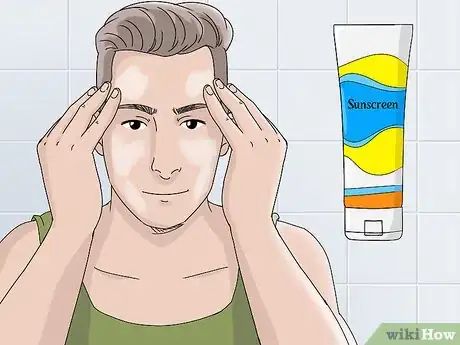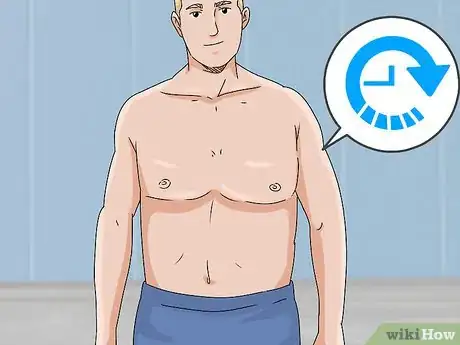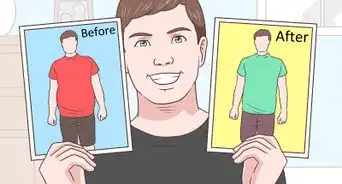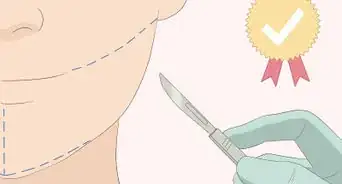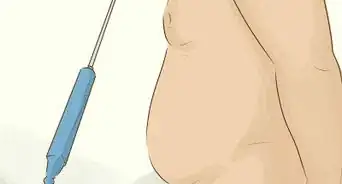This article was co-authored by Pete Cerqua and by wikiHow staff writer, Christopher M. Osborne, PhD. Pete Cerqua is a Certified Personal Trainer and Nutritionist. Pete is also a five-time best-selling author of books including "The 90-Second Fitness Solution" and "High Intensity Fitness Revolution for Women/Men" published by Simon and Schuster and Skyhorse Publishing. Pete has over 20 years of personal training and nutrition coaching experience and operates the 90-Second Fitness flagship studio in New York City.
There are 13 references cited in this article, which can be found at the bottom of the page.
This article has been viewed 25,674 times.
Losing excess weight is one of the most effective ways to improve your overall health. However, you may be worried about developing loose skin after your weight loss, which might affect your self-image. Fortunately, you can reduce your likelihood of developing loose skin by losing weight in a slow, consistent, healthy manner. Protecting and nourishing your skin through simple dietary and lifestyle changes can also help. And, if necessary, you can consider surgery to improve your skin’s appearance.
Steps
Undergoing Slow, Healthy Weight Loss
-
1Develop a healthy weight goal and weight loss plan with your doctor. Instead of trying a crash diet or some other weight loss fad you saw online, schedule an appointment with your doctor. They’ll determine whether you would benefit from losing weight, then work with you to choose the right goals and methods based on your individual circumstances.
- While your body mass index (BMI) can help indicate whether you’d benefit from losing weight, many factors go into determining your ideal weight range. Your doctor may take your medical history, family history, and current fitness level into account, for instance.
-
2Aim to lose about 1 lb (0.45 kg) per week. This slow, steady weight loss pace is widely considered to be the healthiest and most sustainable method. Also, going at this slow and steady pace enables your skin to adjust more consistently to the changes in your body composition.[1]
- Your doctor will likely recommend that you not lose more than 2 lb (0.91 kg) per week, with half that amount being the ideal.
- On average, cutting or burning an additional 500 calories per day (3,500 per week) will enable you to lose 1 lb (0.45 kg) per week.
- Losing weight more slowly can’t eliminate the possibility of getting loose skin, but the odds are much improved versus undergoing a rapid weight loss. Know that it also takes time. It's going to take you an additional six to nine months to maintain that weight for your skin to have its elasticity kicked back in.
Advertisement -
3Work to maintain a total body fat range of between 14% and 22%. This is the recommended healthy body fat range for most adults. Maintaining body fat within this range will also provide a slight plumping effect on your skin. Your doctor can establish your current and recommended body fat percentage.[2]
- If your body fat percentage dips too low, your skin may begin to sag.
-
4Make strength training is a key part of your weight loss exercise program. While doing regular aerobic exercise is critical to losing weight in a healthy fashion, don’t shortchange strength training exercises in the process. Lifting free weights or using weight machines 2-3 times per week will not only help burn calories, but also tighten and tone your muscles. This, in turn, gives your skin a tighter appearance.[3]
- Talk to your doctor before beginning a strength training regimen.
- Lifting weights isn’t the only option for strength training. You can also build muscle tone through activities like yoga and Pilates.
- Make changes to your diet before starting to train. After a few weeks of getting your nutrition in order, you'll start to feel like you really need to get to the gym because you feel great.
Protecting and Nourishing Your Skin
-
1Quit smoking (if you smoke) to improve your health. While smoking poses many more serious health dangers, it also makes it more difficult for your skin to regenerate itself. If you quit smoking—or at least cut back—your skin’s texture, elasticity, and overall health should improve over time.[4]
- Work with your doctor to develop the best smoking cessation strategies for you. You might, for example, employ a combination of nicotine replacement therapy, individual therapy, support group therapy, and stress reduction techniques.
- It can be a challenge to quit smoking and lose weight at the same time. If necessary, quit smoking first, then turn your focus to your weight loss goals.
-
2Use sunscreen and other sun-protection measures. No matter if it’s a sunny or cloudy day, apply a broad-spectrum sunscreen that’s rated at 30 SPF or higher. Sunburns damage your skin’s cells, making them less able to repair and tighten your skin as you lose weight.[5]
- As added protection, wear a broad-brimmed hat and long sleeves and pants when you’re out in the sun. Even when using these measures, try to avoid spending time outdoors around mid-day, when the sun's rays are strongest.
- Avoid using tanning beds as well.
- Damaged skin cells are less able to produce collagen and elastin, both of which help tighten your skin.
-
3Hydrate your skin by drinking water and using moisturizer. Hydrated skin is less likely to develop deep wrinkles, which will make your skin appear even more loose as you lose weight. The easiest way to hydrate your skin is to drink enough water—have a glass in the morning, at night, and before meals, and take sips throughout the day before you feel thirsty.
- Using a daily moisturizer will also hydrate your skin. Choose a moisturizer that contains vitamin C or retinoids, since these may help boost the amount of collagen in your skin. If possible, consider using a combination sunscreen and moisturizer.[6]
-
4Include healthy sources of protein in your diet. The amino acids found in sources of protein support your body’s production of collagen, which helps give your skin its elasticity. While it’s possible to add protein to your diet through supplements like protein powder, it’s best to get it from food sources such as the following:[7]
- Chicken
- Fish
- Low-fat dairy products
- Lean beef
- Eggs
- Beans
- Nuts
-
5Eat fruits and vegetables for vitamin C and antioxidants. Both vitamin C and antioxidants help protect your skin and increase its ability to repair itself. Talk to your doctor if you’re interested in taking vitamin C or antioxidant supplements. More importantly, eat at least 3-5 daily servings of fruits and veggies like the following:[8]
- Strawberries
- Citrus
- Cantaloupes
- Spinach
- Sweet potatoes
- Broccoli
-
6Talk to your doctor about omega-3 supplements for skin elasticity. Omega-3 fatty acids may help improve the appearance of loose and wrinkled skin. Get dietary sources of omega-3 from foods like salmon, mackerel, sardines, flaxseeds, walnuts, soybean oil, and kidney beans. In addition, ask your doctor about taking a daily supplement.[9]
- If your doctor agrees that you might benefit from taking a supplement, buy your omega-3 from a reputable supplier and a manufacturer known for high quality standards.
-
7Look into taking collagen supplements to aid skin repair. While the research is ongoing, it’s possible that collagen supplements may strengthen your skin and help it repair itself. Talk to your doctor to get their thoughts on the potential pros and cons of using collagen supplements.[10]
- Not all experts believe that collagen supplements are a useful way to tighten skin. Also, because the collagen is usually derived from animal tissue from meat processing plants, quality control and potential food allergies are concerns you should discuss with your doctor.[11]
- You can buy collagen supplements in capsule, liquid, or powder form from health stores and online. Choose supplements from a highly-regarded manufacturer and take them according to the product instructions.
Considering Surgery after Weight Loss
-
1Talk to your doctor about your prospects for surgery to remove excess skin. If you’ve made dietary and lifestyle changes and still have loose skin after your weight loss, surgery may be your best remaining option. After consulting with your primary care doctor, meet with a plastic surgeon who specializes in skin tightening procedures.[12]
- If you’ve lost a significant amount of weight—say, 50 lb (23 kg) or more—you're more likely to have loose skin.
- The plastic surgeon may require that you maintain your weight loss for at least 3-6 months before they consider doing surgery.
-
2Undergo the surgery and follow your recovery plan carefully. If you choose to have surgery to remove excess skin, the plastic surgeon will lift, tuck, reshape, and remove skin as needed to make it appear tighter and more contoured. This may be a fairly simple inpatient procedure, or it may be more complex, based on your particular circumstances.[13]
- After the surgery, make sure to follow the rest and recovery procedures outlined by your healthcare team. For example, you may need to take pain medication, limit physical activity, and take additional skincare and sun protection measures.
-
3Maintain a healthy diet and exercise plan to keep the weight off. As you recover from your surgery, ease yourself back into the healthy routines that helped you lose weight in the first place. Once again, consult members of your healthcare team, such as your doctor, physical therapist, nutritionist, and/or personal trainer, to formulate the ideal diet and exercise program for your needs. This might include, for example:
- 150+ minutes of moderate-intensity aerobic exercise per week.
- 2-3 strength training exercise sessions per week.
- 2-3 flexibility training exercise sessions per week.
- Eating a healthy, balanced diet.
- Managing your calorie intake.
- Making other healthy lifestyle choices.
Warnings
- Always discuss an exercise regimen with your doctor before you undertake it, specially if there are any health concerns.⧼thumbs_response⧽
Expert Interview

Thanks for reading our article! If you'd like to learn more about losing weight, check out our in-depth interview with Pete Cerqua.
References
- ↑ http://www.newhealthadvisor.com/how-to-avoid-loose-skin.html
- ↑ https://www.mensfitness.com/weight-loss/burn-fat-fast/best-workout-tighten-loose-skin
- ↑ https://kidshealth.org/en/teens/strength-training.html
- ↑ https://www.ncbi.nlm.nih.gov/pubmed/20839421
- ↑ https://www.cancer.org/latest-news/choose-the-right-sunscreen.html
- ↑ https://www.ncbi.nlm.nih.gov/pmc/articles/PMC3266803/
- ↑ https://www.hsph.harvard.edu/nutritionsource/what-should-you-eat/protein/
- ↑ https://health.clevelandclinic.org/23-foods-good-skin/
- ↑ https://www.ncbi.nlm.nih.gov/pmc/articles/PMC3583891/





